
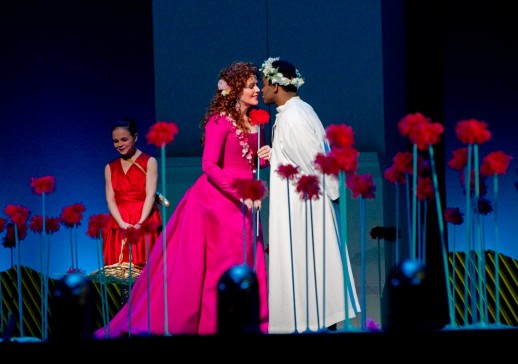
Adelaide di Borgogna, written for the more conservative Rome, was an old-fashioned work firmly rooted in the current tradition, with a contralto en travesti as the hero triumphing in his final rondo, a villain tenor, a full fledged ouverture, recitativi secchi, and very little blurring between set pieces. The time-honored structure consisting of cavatinas, cabalettas, duets (and so on) was still unwaveringly holding sway.
Neapolitan audiences, on the other hand, had a reputation as artistically curious and more prone to innovations. Rossini took full advantage of this in Armida as well as in most of his other operas written for the Teatro San Carlo, each of them presenting – to varying degrees – experimentation and departures from the established praxis.
Armida represents a unicum in his canon, a blend of Italian opera seria, French opéra ballet and opéra fantastique. Structurally, in addition to the division in three acts, what draws immediate attention is the unusual overture, which retains very few archetypal characteristics. It has no modulation leading to a stable passage in the dominant, and if you expect a crescendo, you are in for a big disappointment. The fast principal section consists of a simple figure for strings.
Short dialogic ariosos appear when a more conventional recitative would be expected. Most duets are monopartite. To render them bipartite or tripartite would have meant slackening the atmosphere of ecstatic enchantment engulfing the two lovers. Tripartite, in its perfect classicism, is only the first act duet. The opera has also only one tripartite aria, and it is strangely reserved for a secondary character, Gernando.
The hero has no formal aria, although it may be argued that in the three tenors trio “In quale aspetto imbelle”, Rinaldo’s line is so dominating that it could be viewed as an aria with pertichini. The protagonist, also deprived of a conventional aria, has “only” a rondò with variations. The three finales are highly unusual, ending respectively with a trio with chorus, rondò with ballet, and a “scena” with chorus, as opposed to the traditional ensemble for the finale of Act One and rondò for the end of the opera.
From this summary description it becomes quite evident that by its very nature Armida presents a modern producer abundant and various problems. It is no easy task to maintain the right balance between the human drama of betrayed love and elements of the fantastic.
Mary Zimmerman gives the impression to have favored the latter. Armida’s personal tragedy appears be engulfed by the extravaganza devised by Ms. Zimmerman’s fervid imagination. Her penchant for the supernatural, which according to many was overplayed in her production of Lucia di Lammermoor, can be here given free rein, and allows her to create a visually dazzling, whimsical and elegant production.
The show curtain depicts a maritime tempest with rough waves and menacing clouds. The first “wow” element comes as soon as the curtain opens, when a young girl draped in red, representing Cupid, is quickly lowered head down from the flies “Cirque du Soleil” style. In an obvious reference to the allegorical prologues so common in 17th century opera, she carries a sign saying “Allora fu” (Then it was), and two mimes doubling for Rinaldo and Armida appear to be visibly engage in the act of love, referencing the two lovers’ past relationship. Then Cupid shows another sign with the words “Ora è” (Now it is) and the real action begins.
Armida is given an entry worthy of a true primadonna, as Renée Fleming is wheeled in on a chariot hiding her face with a circular fan, thus delaying the moment when the crusaders (and the audience as well) can finally admire her beauty.
Richard Hudson’s oval ivory-colored wall with several doors is the main set for the entire opera. In the first act it serves as Jerusalem’s walls, while in the second and third act a Palladian ceiling descends to cover it, creating Armida’s enchanted palace. Throughout the opera all sorts of props and decorations are lowered from the flies, including a gazebo where Armida and Rinaldo sing their second act love duet.
The costumes, also designed by Mr. Hudson, are magnificent; those created for Ms. Fleming seem to belong to the period of the opera’s creation, while others are much more chimerical and extravagant, like the get-up worn by Idraote, complete with rat tail and a phallic hat. In the first act, Armida and Idraote, the outsiders, wear black and white, contrasting with the intense, gaudy red robes of the crusaders and the almost Disneyesque world surrounding them.
The production is exuberant with beautiful imagery, and I particularly loved the reference to Bernini’s “Ecstasy of Saint Theresa of Avila”, when Rinaldo, pierced by Cupid’s spear, reduplicates the enraptured contortions of the Spanish mystic’s famous statue. Other elements were less successful, such as the dances of the demons, which were just a bit over the top.
Sometimes Ms. Zimmerman’s propensity for spelling out the obvious (remember the “aria” on the Sonnambula blackboard?) emerges in Armida as well: the sign “Ballo” at the beginning of the ballet and the one reading “Fine” at the end of the opera can become quite trite. Occasionally I thought I was reading a copy of “Allegory for Dummies”.
To sum up, in spite of some components that could be viewed as too “campy” and excessive, the production succeeds because it identifies and remains faithful to the Baroque spirit and derivation of the opera, never failing to take the audience by surprise, always providing it with elements of wonder. It is captivating, never boring. A sizable part of the audience disagreed with me, as the production team received some boos at curtain call.
Despite a plethora of tenors, Armida is a one-woman show. Without Fleming’s championship, it is highly doubtful that it would have ever made it to the Met. Ms. Fleming is one of the most polarizing artists of the last two decades. Like all the greatest singers, she has her share of qualities and flaws: my task is to try to understand and point out what – in my opinion – she brings to or subtracts from this opera, and let the readers judge whether her weaknesses outweigh her strengths or vice versa.
There is no doubt that what she brings to the table is an instrument of rare beauty, which is after all the main reason she has become one of the most celebrated sopranos of our time. I hope I will not sound discourteous if I point out that she has been able to preserve it in relatively good conditions after over twenty years of career and that the passage of time has been benevolent towards her. Her top is still in good shape; signs of mild and inevitable wear and tear can be detected mostly in the more fragile middle and low registers. In a number of roles, she still has few rivals to dethrone her.
Armida is a part of monstrous difficulty. The range is extremely wide, from a low G 2 to a high C 5. The tessitura generally insists on the middle register with frequent incursions towards the top, with many an exposed high C. As I have already recently said, the role of Armida, written by Rossini for his muse and wife, Isabella Colbran, is representative of what used to be called a soprano sfogato, a type of voice with a solid basis in the middle and low registers but also able to sustain frequent and vigorous, and often unexpected ascents to the top.
The coloratura is as intricate as it can get. The soprano is required to execute every possible vocal trick. Trills are abundant: there is even one on a semibreve. The expressive range is varied: every emotion must be expressed, from languid love, to coy and flirtatious deceit and artifice, to bitter desperation, humiliation and finally delirious furor.
When comparing modern singers to the artists of the pre-recording era one is always like treading on shaky ground, and, unlike Armida, I don’t have a crystal ball that allows me to witness a Colbran performance. By studying the scores Rossini composed for her and reading the innumerable reports written about her artistry, I feel however confident enough to say that Colbran’s vocalism must have been remarkably different from Ms. Fleming’s.
The American soprano is by nature better versed in long, drawn-out, languorous lines, where the exquisiteness of her color can better be showcased, and the role of Armida offers her a few opportunities to shine. Unfortunately – and this is a very common assessment – she seems to be too much involved in her own sound.
She often resorts to the infamous mannerisms that have become her hallmark, and that have intensified over the years, tending to slip off the note or slide into it, trailing off into sighs. When this artifice is introduced sparingly, it can be an appropriate effect. Do it constantly and it becomes annoying, and completely out of place in this type of repertoire. It suffices to listen to her 1993 Armida recording to realize how different her approach to the role and to singing in general was then.
I had the impression she was tiptoeing through the role, rather than inhabiting it. Almost everything was sung in a bland mezza voce, as if she were trying to husband her clearly diminished resources. The result was a subdued, rhythmically dead performance, with a lot of stylistically inappropriate, sloppy and enervated coloratura.
A basic rule is to introduce only interpolations (very welcome in this repertoire) that highlight your best features. Ms. Fleming would be better advised to leave out stratospheric puntaturas, which are no longer very successful. Her attempt at a high E flat near the end of the opera turned out to be close to a shriek.
Since her soft-grained voice is not ideal for the coloratura di forza, the final scene loses its impact. Though it can be odious to make comparisons, listening to that finale as sung by Callas or Deutekom gives one an idea of what Rossini may have intended.
It is not a good sign when one of the most famous coloratura showpieces in the history of opera is greeted with only a brief, tepid applause. It was an Armida without Armida. At this point of her career it Ms. Fleming just cannot do full justice to this opera.
Lawrence Brownlee is an excellent singer with a homogenous voice throughout his very wide range, with an easy and precise agility. His instrument also possesses a certain burnished virility not so common among true belcanto tenors. If I were in the mood to split hairs, I could argue that Rinaldo’s tessitura, typical of a Rossini baritenor, is perhaps a trifle too low for him, but he nevertheless acquits himself admirably and fearlessly in a role ranging from low A flat 1 to a high D 4. In this too image-obsessed world, having shed quite a lot of weight will certainly boost his already flourishing career.
One of Armida’s better-known facts is its abundance of tenors. Rossini wrote six tenor roles but gave double assignment to two of them. The Met has opted to employ six different singers. Frankly I do not understand the reason for such splurge: one of these roles is a downright comprimario part, and two others don’t have the music to make them stand out.
José Manuel Zapata possesses a dark-hued voice appropriate for the antagonistic role of Gernando, the beneficiary of the opera’s only tripartite aria. His agility however did not sound smooth and effortless, and the numerous high As showed signs of strain. To his credit, he had the biggest voice of the whole lot.
John Osborn (Goffredo) offered good coloratura and ringing high notes. The characters of Carlo and Ubaldo perform almost always together, singing the same tune in unison or bouncing off the same melody one to the other. Barry Banks’ clarion Carlo overshadowed Kobie van Rensburg’s pale and anonymous Ubaldo.
Among all these high voices, it was refreshing to occasionally hear two basses. Peter Volpe as Idraote and Keith Miller as Astarotte, the leader of Armida’s demons, both provided aptly thundering sounds. Mr. Miller also had a chance to flaunt his celebrated sculpted physique by wearing a very close-fitting spandex demon suit.
Riccardo Frizza, with already ten Rossini operas under his belt, has been rapidly making a name for himself as a belcanto conductor. I have never heard him conduct live before, but his conducting of Armida left me puzzled and perplexed, if not downright frustrated. There were moments of pure beauty, especially in the most lyrical moments. At the beginning of the third act Frizza’s orchestra was mesmerizing and perfectly communicated the magic atmosphere of the enchanted garden: timbres of rare exquisiteness, fine transparencies, polished sonorities utterly translated the climate of such an Arcadian scene.
For much of the opera, however, and particularly in the most agitated moments, Mr. Frizza was sluggish and listless. A more energetic, less indulging conductor might have also probably been able to check Ms. Fleming’s own tendency to dragging tempos.
“Amor possente nome”, with its unrestrained and almost impudent passion, was one of the most popular love duets in the first half of the 19th century. Famous is the description that French writer and Rossini biographer Stendhal made of a performance of Armida in Bologna, where the emotional heat of this duet made many ladies blush and fan themselves. I doubt Mr. Frizza’s apathetic conducting would have produced the same effect on them.
Far from being sold out to begin with, the performance was deserted by at least one fourth of the audience after the second act. Those who remained reserved the loudest applause for the ballet company.
Photos: Ken Howard / Metropolitan Opera














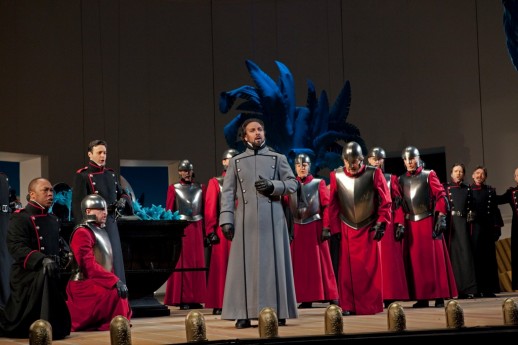
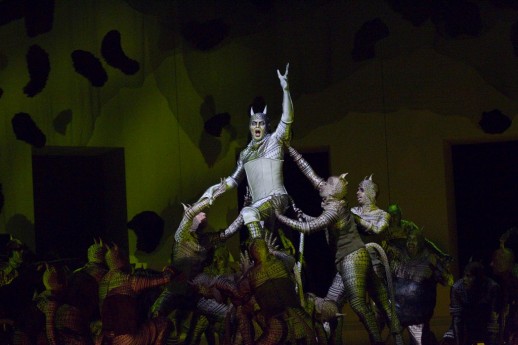
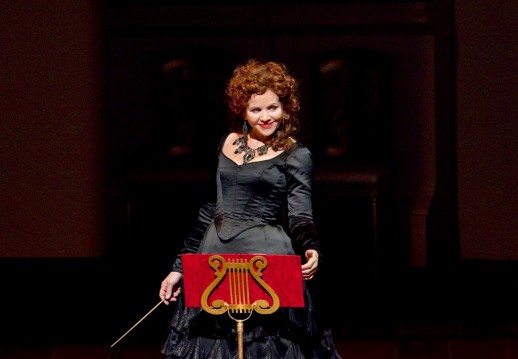
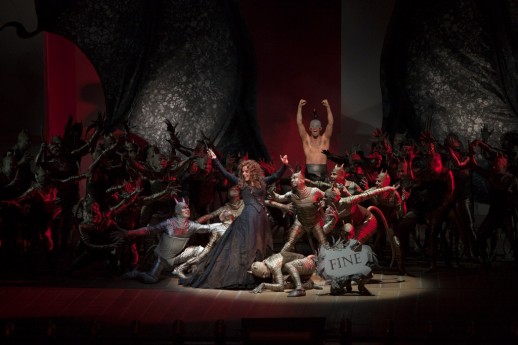











Comments